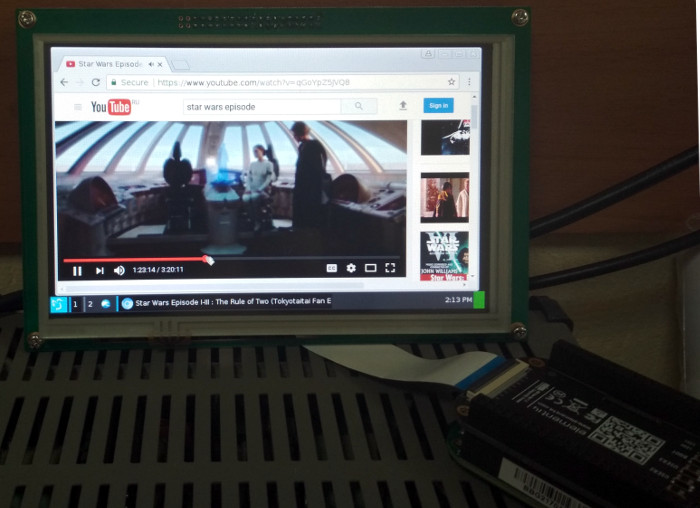BeagleBone: support 7 '' BB-View display on the new linux-4.4 core

The new linux-4.4 kernel has rewritten the mechanism for working with deviceTree. Now they are no longer compiled with the kernel, but are delivered in a separate repository. The last time I tried to get a Chinese 4-inch WaveShare display, there were no adequate manuals. The maximum that I could find is the source code for the old kernel (linux-3.8.13). After spending a week I still assembled my core, which I do not part with.
But time is changing, for a long time everyone switched to Debian 8.7, but I still haven’t found any manuals on how to connect the BB-VIEW display on the new kernel.
Install Debian 8.7 on BeagleBone
- Download a fresh image from the official site .
- Now, under Linux, a convenient utility has appeared for uploading the file system image to the SD card. You no longer need to copy to the console via dd , afraid to make a mistake and wipe the contents of your hard drive. Fill it onto the SD card via Etcher .
- Insert the SD card into BB and wait for download
How to find BeagleBone on the net
There are several standard ways to connect to a BeagleBone console.
- SSH over Ethernet
- UART via Debug-connector on the board (you need to buy a USB-> UART converter)
- We stick the Beaglebone into the USB port, install the drivers, and on our computer the second subnet 192.168.7.0 is created, in which our BeagleBOne will be.
Personally, it’s easier for me to stick the Beaglebone into the router and communicate with it over the network. Only one problem: how to find out his address?
There is nmap utility for this , which scans all live computers on your local network.
Scan the network:
nmap -p 22 192.168.1.1/24
Do not forget to fix it on your subnet (for example, 192.168.0.1, if you had a zero subnet).
And ... we knock on each IP address found:
ssh debian@192.168.1.178
One of them will definitely answer with a greeting.
Debian Update
Perhaps this is obvious, but just in case, I will write.
sudo apt-get update
sudo apt-get upgrade
It is likely that during this operation you may not have enough free space on the SD card. No problem. Turn off Beaglebone, insert the SD card into the computer, and then with gparted just increase the size of the corresponding partition (the main thing is not to change the beginning of the partition).
Where to get display drivers
The easiest way to install overlays is from the debian repository.
Update package with overlays:
sudo apt update ; sudo apt install bb-cape-overlays
Update package with overlays:
If it doesn’t help, then we can collect from source
In general, the overlay repository is now located at .
But! The creators of BeagleBone have already thought out everything for you, and the already cloned repository is on your BeagleBone's SD card at /opt/source/bb.org-overlays
We go there.
We update driver sources to the latest version:
git pull origin master
Updating the DTC compiler:
./dtc-overlay.sh
We assemble and install * .dtbo drivers:
./install.sh
At this point, a new initrd image should be built, including the assembled drivers.
How to enable the desired * .dtbo driver
Consider the example of a 7-inch display BB-VIEW.
We edit the file /boot/uEnv.txt (do not forget sudo, because the owner of the root file)
And insert the following lines (near the end):
cape_disable=bone_capemgr.disable_partno=BB-GREEN-HDMI
cape_enable=bone_capemgr.enable_partno=BB-VIEW-LCD7-01
The first line prohibits the download of the HDMI driver. Because BB-VIEW conflicts on legs with HDMI. The second line - loads the corresponding module.
Reboot and check.
Typical problems
After a reboot, after some time, all the lights go out and the device turns off
Not enough food. Most likely, the BeagleBone turns off when the backlight turns on. It is recommended to use a USB charge with a current of at least 2A with the display. In addition to charging, a USB cable is also important. A bad cable reduces the current and voltage at the input of the beagle. It is best to take short and thick cables.
How to change screen resolution and wrong colors
The Debian desktop image appears, but is flattened to half the screen. How to change the resolution?
Editing the file /etc/X11/xorg.conf. We find the Section “Screen” section there , and in it the DefaultDepth parameter . We set the value to 24. Save, reboot. Should work!
Conclusion
Everything turned out to be simpler than it seemed. I did not even have to rebuild the kernel. Still, life is changing for the better!
Links / Sources
- Latest Debian Builds for BeagleBone
- Repository with overlays . There is also an instruction for use.
- Instructions for connecting the display to the old core
